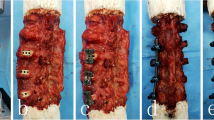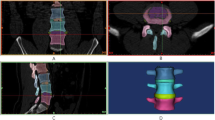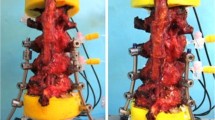Abstract
Segmental instability in degenerative disc disease is often treated with anterior lumbar interbody fusion (ALIF). Current techniques require an additional posterior approach to achieve sufficient stability. The test device is an implant which consists of a PEEK-body and an integrated anterior titanium plate hosting four diverging locking screws. The test device avoids posterior fixation by enhancing stability via the locking screws. The test device was compared to an already established stand alone interbody implant in a human cadaveric three-dimensional stiffness test. In the biomechanical test, the L4/5 motion segment of 16 human cadaveric lumbar spines were isolated and divided into two test groups. Tests were performed in flexion, extension, right and left lateral bending, right and left axial rotation. Each specimen was tested in native state first, then a discectomy was performed and either of the test implants was applied. Finite element analysis (FE) was also performed to investigate load and stress distribution within the implant in several loading conditions. The FE models simulated two load cases. These were flexion and extension with a moment of 5 Nm. The biomechanical testing revealed a greater stiffness in lateral bending for the SynFix-LR™ compared to the established implant. Both implants showed a significantly higher stiffness in all loading directions compared to the native segment. In flexion loading, the PEEK component takes on most of the load, whereas the majority of the extension load is put on the screws and the screw–plate junction. Clinical investigation of the test device seems reasonable based on the good results reported here.








Similar content being viewed by others
References
Arand M, Wilke HJ, Schultheiss M, Hartwig E, Kinzl L, Claes L (2000) Comparative stability of the “Internal Fixator” and the “Universal Spine System” and the effect of crosslinking transfixating systems. A biomechanical in vitro study. Biomed Tech (Berl) 45:311–316
Bozkus H, Chamberlain RH, Perez Garza LE, Crawford NR, Dickman CA (2004) Biomechanical comparison of anterolateral plate, lateral plate, and pedicle screws-rods for enhancing anterolateral lumbar interbody cage stabilization. Spine 29:635–641
Brox JI, Sorensen R, Friis A, Nygaard O, Indahl A, Keller A et al (2003) Randomized clinical trial of lumbar instrumented fusion and cognitive intervention and exercises in patients with chronic low back pain and disc degeneration. Spine 28:1913–1921
Cain CM, Schleicher P, Gerlach R, Pflugmacher R, Scholz M, Kandziora F (2005) A new stand-alone anterior lumbar interbody fusion device: biomechanical comparison with established fixation techniques. Spine 30:2631–2636
Charriere E, Sirey F, Zysset PK (2003) A finite element model of the L5–S1 functional spinal unit: development and comparison with biomechanical tests in vitro. Comput Methods Biomech Biomed Engin 6:249–261
Crawford NR, Brantley AG, Dickman CA, Koeneman EJ (1995) An apparatus for applying pure nonconstraining moments to spine segments in vitro. Spine 20:2097–2100
Cripton PA, Jain GM, Wittenberg RH, Nolte LP (2000) Load-sharing characteristics of stabilized lumbar spine segments. Spine 25:170–179
Fritzell P, Hagg O, Wessberg P, Nordwall A (2001) 2001 Volvo Award Winner in Clinical Studies: Lumbar fusion versus nonsurgical treatment for chronic low back pain: a multicenter randomized controlled trial from the Swedish Lumbar Spine Study Group. Spine 26:2521–2532 discussion 2532–4
Fritzell P, Hagg O, Wessberg P, Nordwall A (2002) Chronic low back pain and fusion: a comparison of three surgical techniques: a prospective multicenter randomized study from the Swedish lumbar spine study group. Spine 27:1131–1141
Kandziora F, Pflugmacher R, Schafer J, Born C, Duda G, Haas NP et al (2001) Biomechanical comparison of cervical spine interbody fusion cages. Spine 26:1850–1857
Keller A, Brox JI, Gunderson R, Holm I, Friis A, Reikeras O (2004) Trunk muscle strength, cross-sectional area, and density in patients with chronic low back pain randomized to lumbar fusion or cognitive intervention and exercises. Spine 29:3–8
Kuzhupilly RR, Lieberman IH, McLain RF, Valdevit A, Kambic H, Richmond BJ (2002) In vitro stability of FRA spacers with integrated crossed screws for anterior lumbar interbody fusion. Spine 27:923–928
Le Huec JC, Liu M, Skalli W, Josse L (2002) Lumbar lateral interbody cage with plate augmentation: in vitro biomechanical analysis. Eur Spine J 11:130–136
Oxland RT, Lund T (2000) Biomechanics of stand-alone cages and cages in combination with posterior fixation: a literature review. Eur Spine J 9(Suppl 1):S95–101
Panjabi MM, Abumi K, Duranceau J, Crisco JJ (1988) Biomechanical evaluation of spinal fixation devices: II. Stability provided by eight internal fixation devices. Spine 13:1135–1140
Polikeit A, Ferguson SJ, Nolte LP, Orr TE (2003) Factors influencing stresses in the lumbar spine after the insertion of intervertebral cages: finite element analysis. Eur Spine J 12:413–420
Resnick DK, Choudhri TF, Dailey AT, Groff MW, Khoo L, Matz PG et al (2005) Guidelines for the performance of fusion procedures for degenerative disease of the lumbar spine. Part 11: interbody techniques for lumbar fusion. J Neurosurg Spine 2:692–699
Wong C, Gehrchen PM, Darvann T, Kiaer T (2003) Nonlinear finite-element analysis and biomechanical evaluation of the lumbar spine. IEEE Trans Med Imaging 22:742–746
Acknowledgments
This study was supported by Synthes GmbH, Oberdorf, Switzerland.
Author information
Authors and Affiliations
Corresponding author
Rights and permissions
About this article
Cite this article
Schleicher, P., Gerlach, R., Schär, B. et al. Biomechanical comparison of two different concepts for stand alone anterior lumbar interbody fusion. Eur Spine J 17, 1757–1765 (2008). https://doi.org/10.1007/s00586-008-0797-4
Received:
Revised:
Accepted:
Published:
Issue Date:
DOI: https://doi.org/10.1007/s00586-008-0797-4




